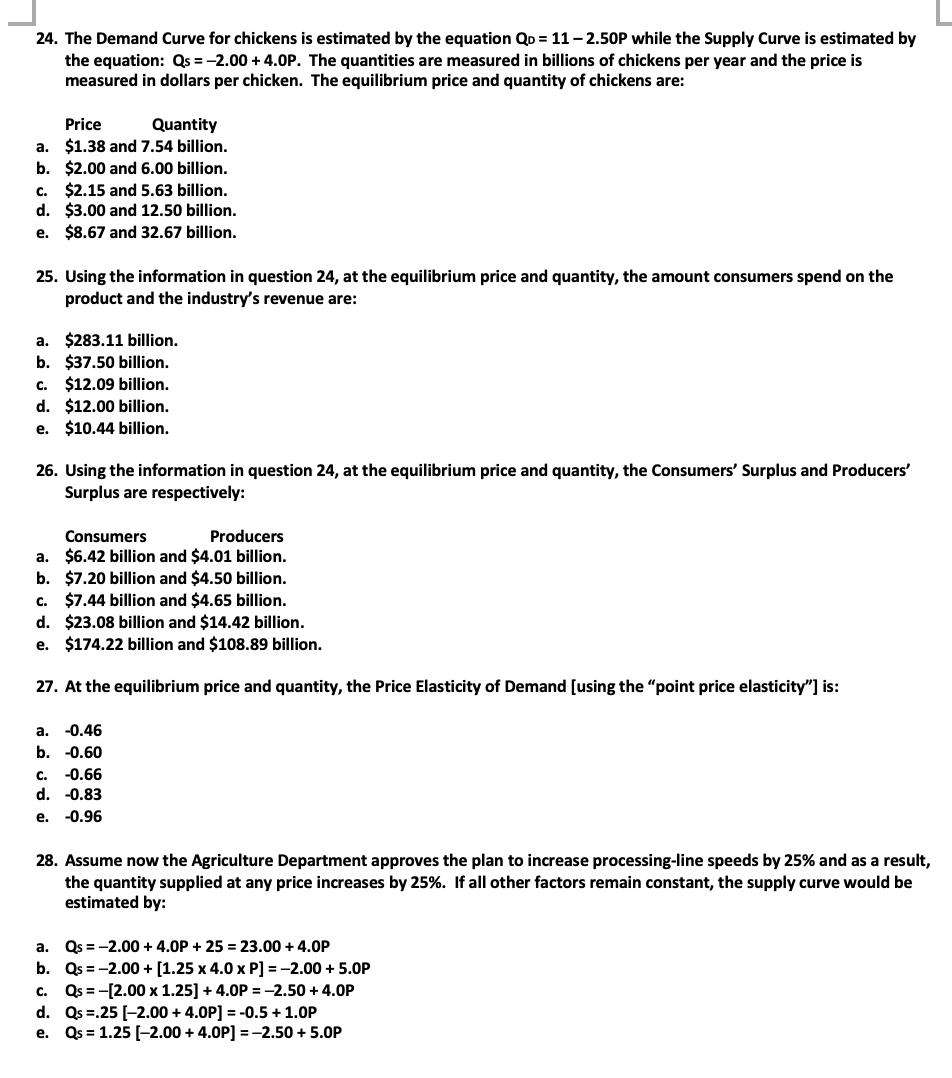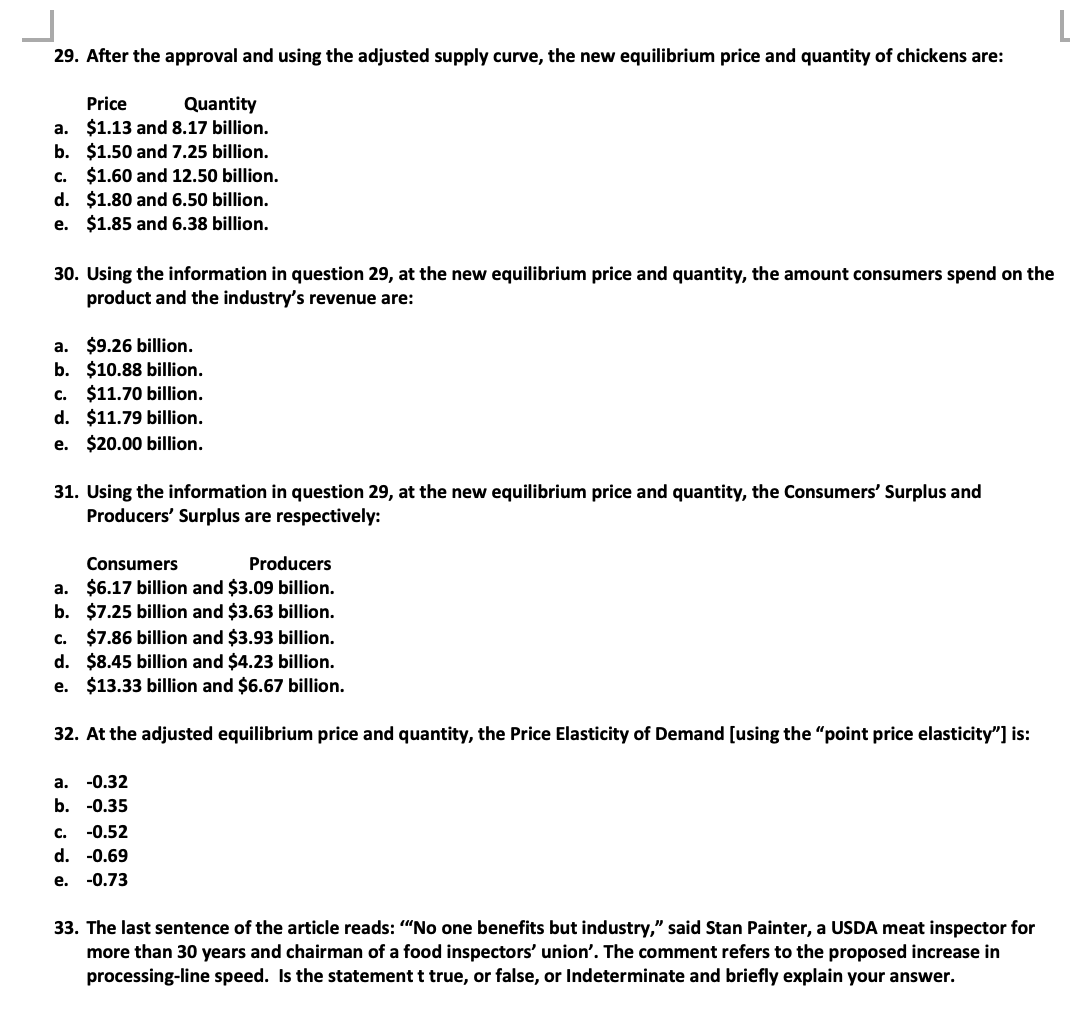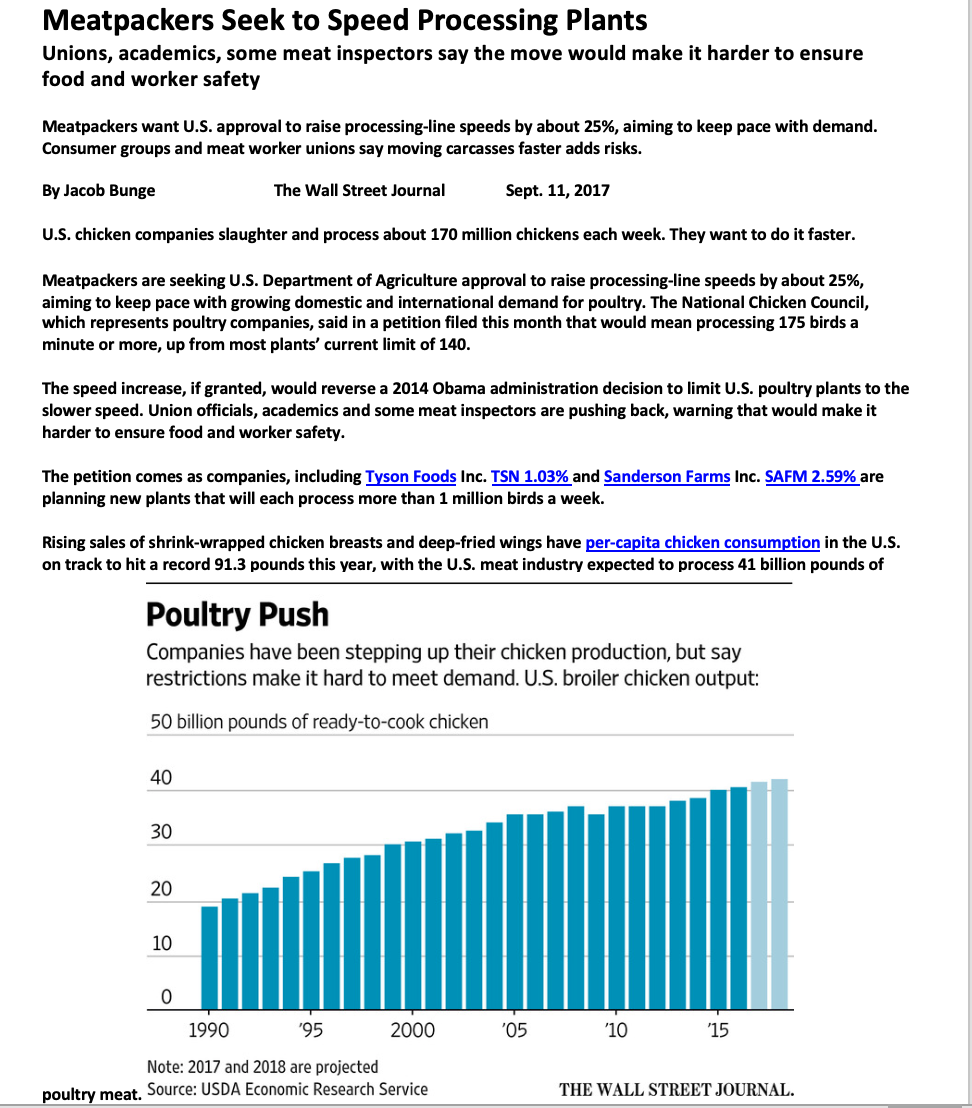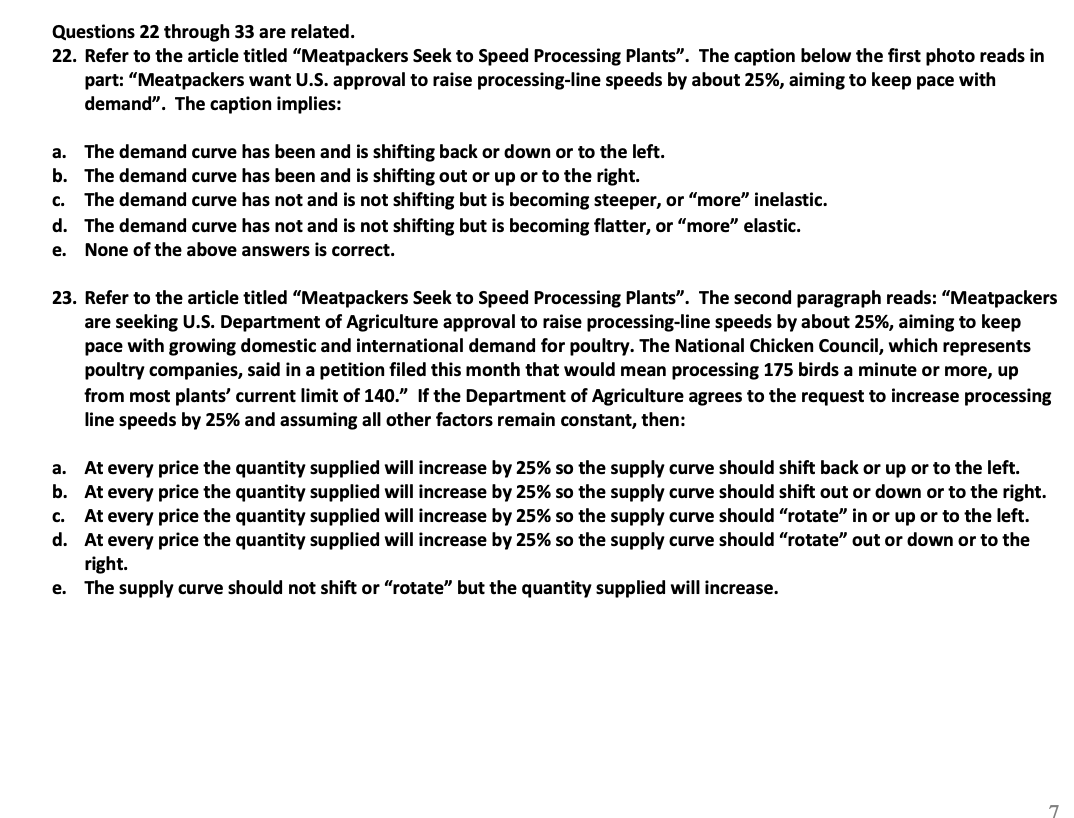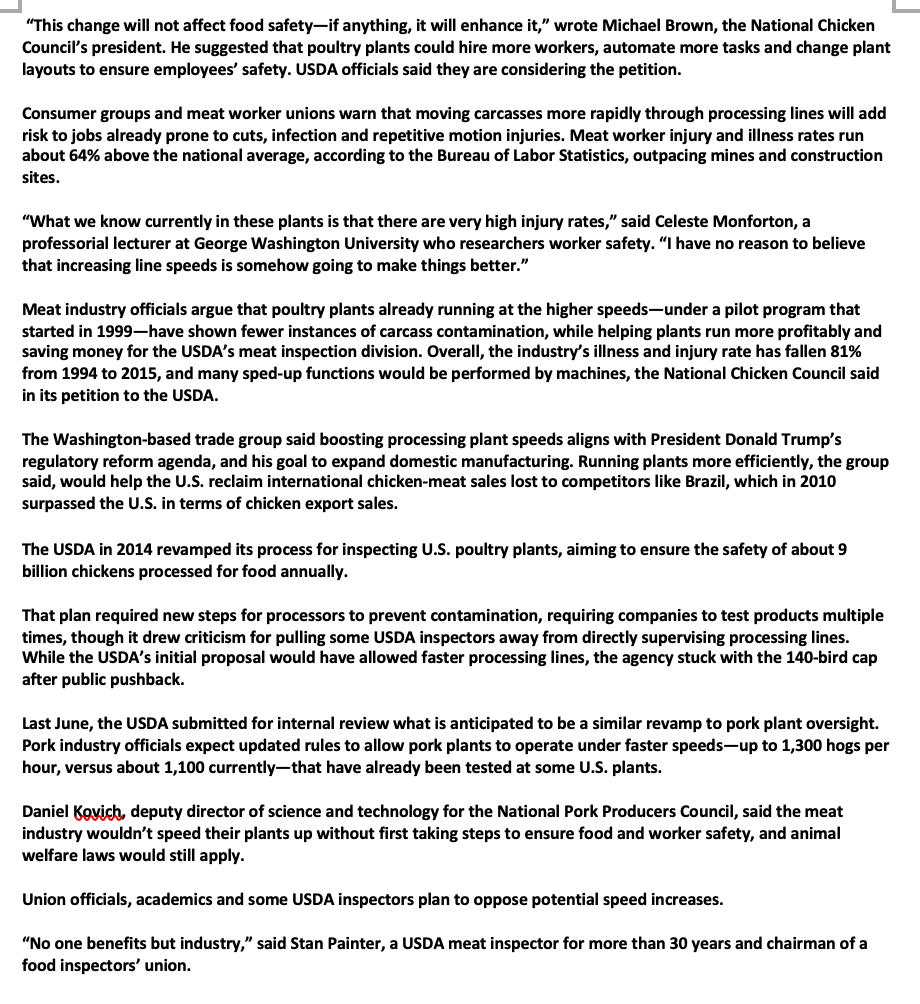Please ONLY ANSWER NUMBER 33. and EXPLAIN WHY be clear.
_| 24. The Demand Curve for chickens is estimated by the equation (In = 11 2.50P while the Supply Curve is estimated by the equation: (15 = 2.00 + 4.0P. The quantities are measured in billions of chickens per year and the price is measured in dollars per chicken. The equilibrium price and quantity of chickens are: Price Quantity $1.38 and 7.54 billion. $2.00 and 6.00 billion. $2.15 and 5.63 billion. $3.00 and 12.50 billion. $8.67 and 32.67 billion. Using the information in question 24, at the equilibrium price and quantity, the amount consumers spend on the product and the industry's revenue are: $233.11 billion. $37.50 billion. $12.09 billion. $12.00 billion. $10.44 billion. Using the information in question 24, at the equilibrium price and quantity, the Consumers' Surplus and Producers' Surplus are respectively: Consumers Producers $6.42 billion and $4.01 billion. $7.20 billion and $4.50 billion. $7.44 billion and $4.65 billion. $23.08 billion and $14.42 billion. $174.22 billion and $103.39 billion. At the equilibrium price and quantity, the Price Elasticity of Demand [using the \"point price elasticity\"] is: 0.46 0.60 0.66 0.83 0.96 Assume now the Agriculture Department approves the plan to increase processing-line speeds by2596 and as a result, the quantity supplied at any price increases by 25%. If all other factors remain constant, the supply cunre would be estimated by: Qs= 2.00 + 4.0P + 25 = 23.00 +4.0P Qs= 2.00 + [1.25 x 4.0 II P] = 2.00 + 5.0P [ls = [2.00 II: 1.25] + 4.0P = 2.50 + 4.0P a5 =.25 [2.00 + 4.09] = 41.5 + 1.0P [ls = 1.25 [2.00 + 4.0P] = 2.so + 5.0:: _| 29. 32. After the approval and using the adjusted supply curve, the new equilibrium price and quantity of chickens are: Price Quantity $1.13 and 8.17 billion. $1.50 and 7.25 billion. $1.60 and 12.50 billion. $1.80 and 6.50 billion. $1.85 and 6.38 billion. . Using the information in question 29, at the new equilibrium price and quantity, the amount consumers spend on the product and the industry's revenue are: $9.26 billion. $10.88 billion. $11.70 billion. $11.79 billion. $20.00 billion. . Using the information in question 29, at the new equilibrium price and quantity, the Consumers' Surplus and Producers' Surplus are respectively: Consumers Producers $6.17 billion and $3.09 billion. $7.25 billion and $3.63 billion. $7.86 billion and $3.93 billion. $8.45 billion and $4.23 billion. $13.33 billion and $6.67 billion. At the adjusted equilibrium price and quantity, the Price Elasticity of Demand [using the \"point price elasticity\"] is: 43.32 -O.35 -0.52 43.69 -O.73 33. The last sentence of the article reads: \"No one benefits but industry,\" said Stan Painter, a USDA meat inspector for more than 30 years and chairman of a food inspectors' union'. The comment refers to the proposed increase in processing-line speed. Is the statement t true, or false, or Indeterminate and briey explain your answer. Meatpackers Seek to Speed Processing Plants Unions, academics, some meat inspectors say the move would make it harder to ensure food and worker safety Meatpackers want U.S. approval to raise processing-line speeds by about 25%, aiming to keep pace with demand. Consumer groups and meat worker unions sayr moving carcasses faster adds risks. Ev Jacob Bunge The Wall Street Journal Sept. 11, 2017 U5. chicken companies slaughter and process about 170 million chickens each week. 'I'hevr want to do it faster. Meatpackers are seeking U.S. Department ongrIculture approval to raise processing-line speeds bvabout 25%, aimingto keep pace with growing domestic and International demand for poultry. The National Chicken Council, which represents poultry companies, said In a petition led this month that would mean processing 115 birds a minute or more, up from most plants' current limit of 140. The speed increase, If granted, would reverse a 2014 Obama ad ministration decision to lImit U.S. poultry plants to the slower speed. Union ofcials, academics and some meat inspectors are pushing back, warning that would make It harder to ensure food and worker safety. The petition comes as companies, including Tn Foods Inc. TSN 1.03% and Sanderson Farms Inc. SAFM 2.59% are planning new plants that will each process more than 1 million birds a week. Rising sales of shrink-wrapped chicken breasts and deep-fried wings have Er-capita chicken consumgion in the U.S. on track to hit a record 31.3 pounds this year. with the U.S. meat Industry expected to process 41 billion pounds of Poultry Push Companies have been stepping up their chicken production. but say restrictions make it hard to meet demand. U.S. broiler chicken output: 50 billion pounds of ready-tocook chicken 40 30 __20 10 1990 '95 2000 '05 '10 '15 Note: 2017 and 2018 are projected poultry meat Source: USDA Economic Research Service THE WALL STREET JOURNAL. Questions 22 through 33 are related. 22. Refer to the article titled \"Meatpackers Seek to Speed Processing Plants\". The caption below the first photo reads in P-PP' part: "Meatpackers want U.S. approval to raise processing-line speeds by about 25%, aiming to keep pace with demand\". The caption implies: The demand curve has been and is shifting back or down or to the left. The demand curve has been and is shifting out or up or to the right. The demand curve has not and is not shifting but is becoming steeper, or "more\" inelastic. The demand curve has not and is not shifting but is becoming atter, or "more\" elastic. None of the above answers is correct. Refer to the article titled "Meatpackers Seek to Speed Processing Plants\". The second paragraph reads: \"Meatpackers are seeking U.S. Department of Agriculture approval to raise processing-line speeds by about 25%, aiming to keep pace with growing domestic and international demand for poultry. The National Chicken Council, which represents poultry companies, said in a petition filed this month that would mean processing 175 birds a minute or more, up from most plants' current limit of 140.\" If the Department of Agriculture agrees to the request to increase processing line speeds by 25% and assuming all other factors remain constant, then: At every price the quantity supplied will increase by 25% so the supply curve should shift back or up or to the left. At every price the quantity supplied will increase by 25% so the supply curve should shift out or down or to the right. At every price the quantity supplied will increase by 25% so the supply curve should \"rotate\" in or up or to the left. At every price the quantity supplied will increase by 25% so the supply curve should \"rotate\" out or down or to the right. The supply curve should not shift or \"rotate\" but the quantity supplied will increase. _I I \"This change will not affect food safetyif anything, it will enhance it,\" wrote Michael Brown, the National Chicken Council's president. He suggested that poultry plants could hire more workers, automate more tasks and change plant layouts to ensure employees' safety. USDA officials said they are considering the petition. Consumer groups and meat worker unions warn that moving carcasses more rapidly through processing lines will add risk to jobs already prone to cuts, infection and repetitive motion injuries. Meat worker injury and illness rates run about 64% above the national average, according to the Bureau of Labor Statistics, outpacing mines and construction sites. "What we know currently in these plants is that there are very high injury rates," said Celeste Monforton, a professorial lecturer at George Washington University who researchers worker safety. "I have no reason to believe that increasing line speeds is somehow going to make things better.\" Meat industry ofcials argue that poultry plants already nrnning atthe higher speedsunder a pilot program that started in mashm shown fewer instances of carcass contamination, while helping plants run more protably and saving money for the USDA's meat inspection division. Overall, the industry's illness and injury rate has fallen 01% from 1994to 2015, and many sped-up functions would be performed by machines, the National Chicken Council said in its petition to the USDA. The Washington-based trade group said boosting processing plant speeds aligns with President Donald Tmmp's regulatory reform agenda, and his goal to expand domestic manufacturing. Running plants more efficiently, the group said, would help the U.S. reclaim international chicken-meat sales lost to competitors like Brazil, which in 2010 surpassed the U.S. in terms of chicken export sales. The USDA in 2014 revamped its process for inspecting U.S. poultry plants, aiming to ensure the safety of about 9 billion chickens processed for food annually. That plan required new steps for processors to prevent contamination, requiring companies to test products multiple times, though it drew criticism for pulling some USDA inspectors away from directly supervising processing lines. While the USDA's initial proposal would have allowed faster processing lines, the agency stuck with the 140-bird cap after public pushback. last June, the USDA submitted for internal review what is anticipated to be a similar revamp to pork plant oversight. Pork industry officials expect updated rules to allow pork plants to operate under faster speedsup to 1,300 hogs per hour, versus about 1,100 currentlythat have already been tested at some U.S. plants. Daniel W deputy director of science and technology for the National Pork Producers Council, said the meat industry wouldn't speed their plants up without rst taking steps to ensure food and worker safety, and animal welfare laws would still apply. Union officials, academics and some USDA inspectors plan to oppose potential speed increases. \"No one benefits but industry," said Stan Painter, a USDA meat inspector for more than 30 years and chairman of a food inspectors' union
